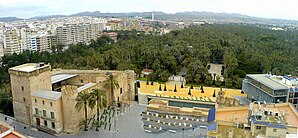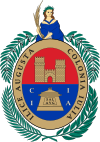Moose
| Elche / Elx | ||
|---|---|---|

|
||
| coat of arms | Map of Spain | |

|
|
|
| Basic data | ||
| Autonomous Community : | Valencia | |
| Province : | Alicante | |
| Comarca : | Bajo Vinalopó | |
| Coordinates | 38 ° 16 ′ N , 0 ° 41 ′ W | |
| Height : | 85 msnm | |
| Area : | 326.10 km² | |
| Residents : | 232,517 (Jan 1, 2019) | |
| Population density : | 713.02 inhabitants / km² | |
| Postal code : | 03200 to 03299 | |
| Municipality number ( INE ): | 03065 | |
| Nearest airport : | Alicante | |
| administration | ||
| Mayoress : | Carlos González (PSOE) | |
| Website : | www.elx.es | |
Elche [ ˈeltʃe ], in Valencian Elx [ ɛltʃ ] (both forms are official) is a Spanish city in the autonomous region of Valencia in the province of Alicante around 20 km southwest of Alicante and the Costa Blanca on the Vinalopó river .
history
The city of Elche can be traced back to the Iberians , who lived about two kilometers from today's city around 600 BC. Lived in the village of Helike . After the conquest by the Roman Empire , the city was preserved and developed as Ilici . The Moors conquered Spain in the 8th century and gave the city its current name.
A bust from the Iberian era was found south of today's city on August 4, 1897 . This is known as the Dama de Elche and is on display in the National Archaeological Museum in Madrid .
Culture and sights
The Historical and Archaeological Museum ( MAHE ) has existed since May 2006 and brings visitors closer to the long history of Elche .
The city is known for its palm gardens, the largest, El Palmeral , in 2000 by the UNESCO for World Heritage Site was declared and for the Masterpieces of the Oral and Intangible Heritage of Humanity counting mysteries of Elche .
Museums
Museo Arqueológico y de Historia de Elche
The Historical and Archaeological Museum (MAHE) has existed since May 2006 and brings visitors closer to the long history of Elche. It is located inside the Palacio de Altamira in the historic old town of Elche, near the Basilica of Santa María. As a permanent exhibition, the museum gives an overview of the development of the different epochs in the city - such as the Neolithic, the Copper Stone Age, the Bronze Age, the Iberian Age, Romanization, Islamic settlement, etc. up to the present day. The archaeological exhibits come from the archaeological sites of La Alcudia, El Arenero de Monforte del Cid. And from the Parque de Elche (located within the city's gardens).
Museo de la Festa
The Museo de la Festa deals with the Mystery Games of Elche with the aim of giving visitors an insight into the games throughout the year. On the one hand, the museum shows the stage design with costumes and the like, and on the other hand visual and auditory effects of the games.
Museo del Palmeral
The Museo del Palmeral is located in a typical building in the San Plácido garden, near the Huerta del Cura. It shows the origins, history and culture of palm planting. The content is presented using videos, display boards, visual and auditory elements and finally through the garden itself.
Centro de Cultura Tradicional Museo Escolar de Pusol
The museum houses unique finds on ethnological aspects (agriculture, trade, industry, folklore, traditions, etc.).
Attractions
Basílica de Santa María
The Basílica de Santa María was built on the site of the mosque of the Islamic era between the 17th and 18th centuries. It is a clear example of the Spanish baroque. The basilica was partially destroyed during the civil war, but rebuilt years later according to plans by the Iberian architect Antonio Serrano Peral.
Torre de la Calahorra
The Torre de la Calahorra is a rectangular Almohad fortification built between the late 12th and early 13th centuries. It was part of the ramparts around the medieval village and defended the entrance that led to Alicante. Exhibitions are currently shown occasionally.
Torre del Consell
The Torre del Consell is the current seat of the Elche City Council. It is located on the Patza de Baix. The construction goes back to the 15th century.
Palacio de Altamira
The palace of Altamira was built at the end of the 15th century by the nobleman Gutierre de Cárdenas and was the first residence. It is likely that it was built on the walls of an earlier 12th or 13th century structure that was part of the Almohad city wall.
Sports
Elche is the hometown of the football club FC Elche , which achieved direct promotion in the 2012/13 season and thus returned to the Primera División after 24 years , but currently has to compete in the second division again . FC Elche plays its home games at the Martínez Valero Stadium , which was also the venue for the 1982 World Cup .
Town twinning
Sister cities of Elche are
sons and daughters of the town
- José Manuel Sempere (* 1958), football player
- David Muñoz (* 1979), racing cyclist
- Miguel Ángel López Jaén (* 1982), tennis player
- Pablo de Lucas Torres (* 1986), football player
- Sílvia Soler Espinosa (* 1987), tennis player
- Aarón Ñíguez (* 1989), football player
- Tamara Gómez Garrido (* 1991), triathlete
- Saúl (* 1994), football player
- Mario Vilella Martínez (born 1995), tennis player
Web links
Individual evidence
- ↑ Cifras oficiales de población resultantes de la revisión del Padrón municipal a 1 de enero . Population statistics from the Instituto Nacional de Estadística (population update).
- ↑ Visitelche.com: Archeology and History Museum of Elche ( Memento of the original from May 28, 2014 in the Internet Archive ) Info: The archive link has been inserted automatically and has not yet been checked. Please check the original and archive link according to the instructions and then remove this notice. Retrieved August 29, 2014.
- ↑ Museo del Palmeral de Elche ( Memento of the original from November 1, 2014 in the Internet Archive ) Info: The archive link has been inserted automatically and has not yet been checked. Please check the original and archive link according to the instructions and then remove this notice. . Official tourism website. Retrieved September 12, 2014.
- ↑ EL Museo Escolar de Pusol, reconocido por la UNESCO . In: El Mundo, October 1, 2009. Retrieved August 29, 2014.
- ↑ Centro de Cultura Tradicional Museo Escolar de Pusol . Official website. Retrieved September 12, 2014.
- ↑ Spain.info: Santa María Basilica.Retrieved August 29, 2014.
- ↑ Conselleria de Educación, Cultura y Deporte ( page no longer available , search in web archives ) Info: The link was automatically marked as defective. Please check the link according to the instructions and then remove this notice. . Official website of the Ministry of Education, Culture and Sport. Retrieved September 12, 2014.
- ↑ Absolutely moose







